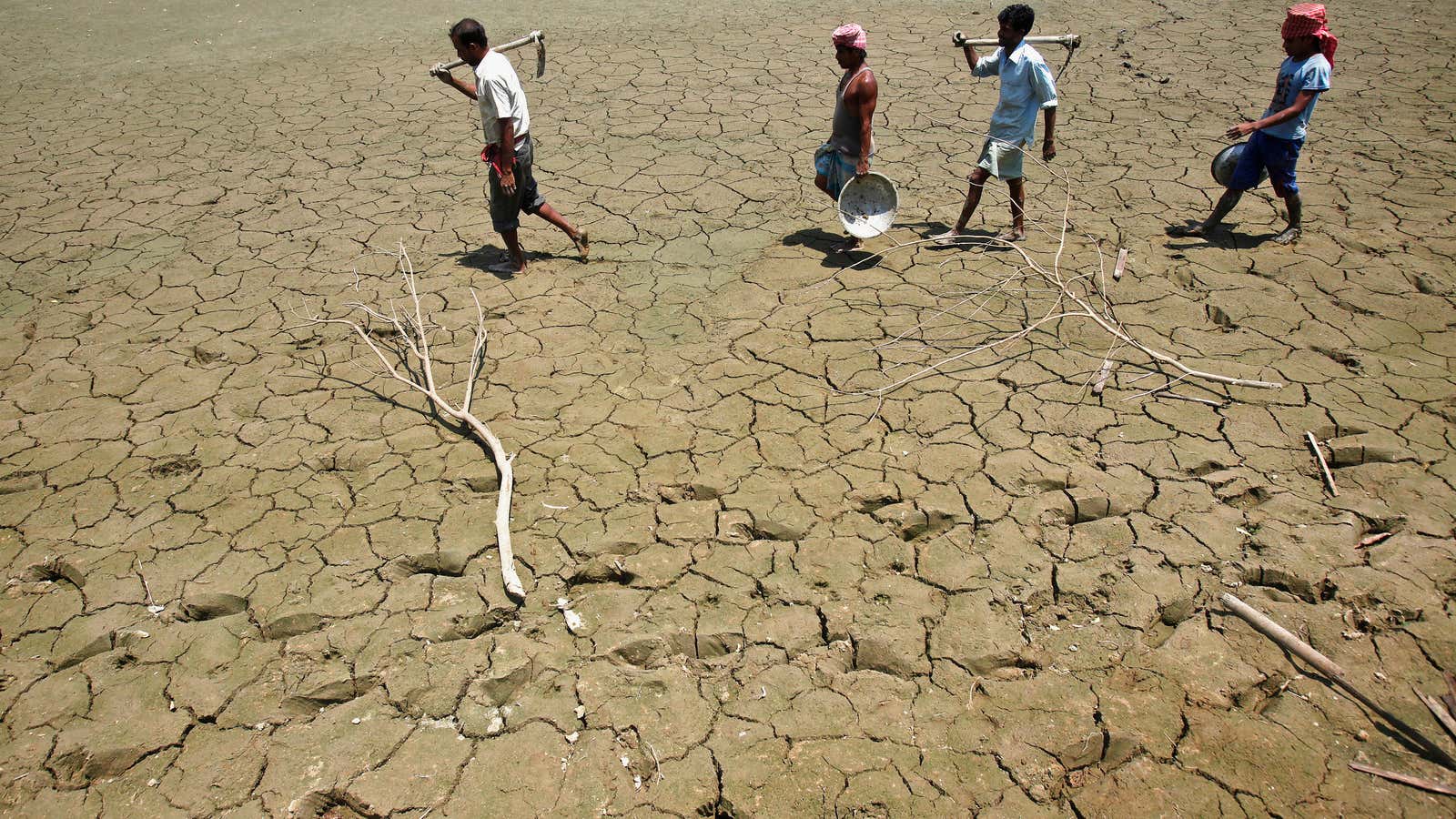Climate change may be responsible for an increase in Indian suicides in numbers equal to the entire population of Santa Cruz, California.
A study published this week in the Proceedings of the National Academy of Sciences found that the rise in average temperature due to climate change since 1980 correlates with a rise in the rates of suicides in India. Overall, the study argues, some 60,000 people committed suicide in India because of climate change that wouldn’t have otherwise.
Farming is a high-stress job everywhere; it has one of the highest rates of suicides of any profession worldwide. Previous research to find the cause has focused more on access to firearms, and the loneliness and stress of the work, and hasn’t looked at whether loss of crops due to climate change could be a contributing factor. Tama Carleton, a University of California-Berkeley climate-change researcher and author of the study, says she wants to bring greater attention to the human impact of climate change. “It’s a lot easier for us to think about measuring crop yields, or total economic impact,” she says.
India ranks highly in the World Health Organization’s list of country-wide suicide rates. In 2015, the last year for which data are available, India suffered suicides at a rate of 16 per 100,000 people. Most of the world’s wealthier countries fall in a range between the UK, which had a suicide rate of 7.4 per 100,000 people in 2015 and the US at the higher end, with a rate of around 12.6 per 100,000 people.
Because India is the world’s second-most populous country, topping out at well over 1 billion people, its high suicide rate makes for staggering raw numbers. According to the Indian National Crime Records Bureau, over 132,000 Indians made the painful choice to end their own life in 2015, the most recent year for which records are available. And because more than half of India’s workforce is connected to agriculture in some way, this means farmer suicide is in many ways a problem unique to the country: nearly 10% of the 2015 suicides were people working in the farming sector, or just over 12,000 people.
There’s no shortage of anecdotal evidence linking climatic shock with suicide rate increases. Al-Jazeera covered this depressing phenomena in 2015, in an article that began with accounts of farmers cursing the skies and then ingesting pesticides. “In the last 20 years, nearly 300,000 farmers have ended their lives,” reporter Baba Umar wrote. “Forty-one farmers commit suicide every day, leaving behind scores of orphans and widows.” (That’s not too far off from the Indian government’s estimates; 12,000 a year is about 33 per day.) Earlier in 2015 Mother Jones wrote that “Since the mid-1990s, around 300,000 Indian farmers have killed themselves—a rate of about one every 30 minutes.”
The size of the problem, coupled with legally dictated rigorous recordkeeping methods, may make India the only place where the data exist in sufficient scope and fine enough detail to allow for the kind of analysis Carelton did. By cross-referencing government records, harvest yields, and weather patterns, and isolating for variables such as crop variety, and time of year, Carleton teased out a correlation between climate change and suicide rates: that every 1°C rise in temperature during the growing season, on any day above 20°C (68°F), results in an additional 67 suicides across all of India.
Correlation does not imply causation, warns David Banks, a statistics expert from Duke University, who was not involved in the study. However, he adds, “the causal case does seem strong here, particularly since heat in the non-growing season is not associated with a rise in suicides.” Richard Smith, an environmental statistics expert at the University of North Carolina-Chapel Hill, who was also not involved with the project, described the work as “a truly impressive paper.”
Because of climate change, India is only going to get hotter. Starting in 2014, each subsequent year has shattered the previous year’s record as the hottest ever. Scientific consensus predicts average global temperatures to rise as much as 3°C by 2050. Carleton says that interventions have been either wholly absent or woefully insufficient over the period of time her study covers, and without an increase in measures like subsidized crop insurance, worker retraining, or low-cost loans available to farmers to keep them afloat when harvests suffer, India is looking down the barrel of more frequent hardship and, sadly, more lives lost to self-harm.
Correction: An earlier version of this post attributed the article to the wrong journal.
